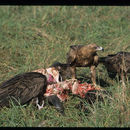Biology
(
англиски
)
добавил Arkive
The tawny eagle is most frequently seen soaring high in the air or perched at the top of a tree, scanning the ground for prey (6). A formidable hunter, the tawny eagle will tackle mammals as large as hares, as well as sizeable birds and lizards, which it catches by making a rapid dive from its perch or during flight, seizing the animal in its powerful talons. When available, this species will also exploit a variety of other food sources such as carrion, insects, amphibians and fish, and frequently steals food from other birds, such as storks, raptors and ground-hornbills (2).
The tawny eagle's breeding season varies according to location, but most commonly occurs in the dry season (2). Courtship consists of aerial displays, during which this normally silent species makes a series of noisy croaks and grunts (7). After mating, a large, flat nest is constructed from sticks lined with grass and leaves, usually at the top of a thorny tree or very occasionally on a power pylon (2) (6). A clutch of two eggs is laid, which hatch after around 39 to 44 days. During the early stages of the 77 to 84 day fledging period, while the chicks are still small, the eldest chick may kill the younger sibling (2) (8). A single nest may be used repeatedly for many years, so long as the crown of the tree remains unaltered (8). Tawny eagles have a relatively long lifespan, reaching up to 16 years (5).
Conservation
(
англиски
)
добавил Arkive
There are currently no specific conservation measures in place for the tawny eagle (1). Throughout its extensive range this species can be found in a number of protected areas, including several large national parks such as Kruger National Park in South Africa (2).
Description
(
англиски
)
добавил Arkive
Common and widespread, the tawny eagle is a relatively large, handsome bird of prey, with heavily feathered legs (4) (5). The plumage is generally tawny to rusty brown in colour, often with dark markings on the wings, especially the flight-feathers (2) (4). Three subspecies are currently recognised, which occupy different geographical regions, and vary slightly in size, markings and colouration (2). During its first year, the immature tawny eagle's plumage is much paler than the adults, often whitish, especially on the underparts (2) (4).
Habitat
(
англиски
)
добавил Arkive
Throughout its wide range the tawny eagle may be found in a variety of habitats, but principally open savanna and arid steppe. It is absent from forests and areas of true desert (2).
Range
(
англиски
)
добавил Arkive
There are two African tawny eagle subspecies, Aquila rapax rapax, which can be found throughout southern Africa, as well as south-eastern parts of Central Africa, and Aquila rapax belisarius, which is found in Morocco, Algeria, much of tropical Africa between the Sahara and the equator, and also southern Arabia. In Asia, the subspecies Aquila rapax vindhiana occupies much of India, Pakistan and southern Nepal as well as parts of Myanmar and Vietnam (1) (2).
Status
(
англиски
)
добавил Arkive
Classified as Least Concern (LC) on the IUCN Red List (1) and listed on Appendix II of CITES (3).

